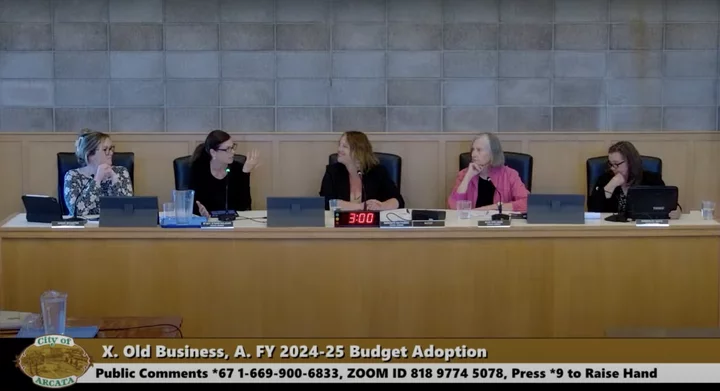Screenshot of Wednesday’s special meeting.
At a special meeting Wednesday night, the Arcata City Council voted to place a three-quarter percent sales tax measure on November’s ballot. If approved by voters, the tax would generate about $2.6 million of revenue annually, going into effect in April 2025.
The agenda item came just after the Council approved Arcata’s proposed budget for the upcoming fiscal year. Although the City’s finances are stable at the moment, budget deficits are present and expected to continue over the next several years.
“The city has done a really good job of laying a good solid fiscal or financial foundation. But when we look out, we’re looking at budget deficits every year going forward,” said Director of Finance Tabatha Miller.
“We’re looking at running into the negative, and you can do that for a few years, especially if you have some reserves saved up like we do. But there’s a point when you cross that line, and it’s a problem.”
Councilmember Kimberley White chimed in: “We wouldn’t want to get into the position of where the county is right now.”
“No, we do not,” Miller agreed, “we do not want to be in a crisis.”
The Transactions and Use Tax (TUT) ballot measure could help avoid a crisis. If passed, it would increase Arcata’s current sales and use tax rate of 8.5 percent to 9.25 percent. Miller said that the county is expected to put a similar .75 percent sales tax on the ballot, meaning that Arcata residents would soon pay a ten percent tax if voters approve both measures.
Because it would join the general fund, uses for the revenue are unrestricted, Miller said. The revenue could help fund the city’s community ambassador program, juvenile diversion counselors, a new community center in Valley West and general infrastructure maintenance, among other things.
Councilmember White said that an effort to educate community members about these services might be important before November.
“It’s these programs that we’re going to lose, if it doesn’t pass,” White said. “I feel like our constituents need to hear that – in particular the community ambassador program.”
In an April survey of Arcata voters, 72 percent of 567 respondents said they would support the tax.
“That’s a pretty good number going into putting it on the ballot,” Miller said.
###
Prior to the tax discussion, the Council approved the City’s $87.6 million spending plan for the fiscal year 2024-2025, which begins on July 1st.
Arcata is looking at a deficit of about $3 million, with just $84.5 million in projected revenue in the coming year. However, the City has built up reserves over the last few years that will cover any shortfall.
Those reserves, totaling $15.9 million in Arcata’s general fund, are equal to around 299 days of operations, Miller said in an email to the Outpost.
“So if your general fund stopped taking money in tomorrow, you could almost get through a full year of operations just on your reserves […] which is something that puts us in good stead,” Miller said at the meeting.
“When we start talking about structural deficits and some of the challenges we have, I do want to just commend the council and the city on really sort of putting us in a solid position so that we’re not panicking.”
One of the more noteworthy deficits is the stormwater fund. For several years, maintenance to the City’s stormwater drainage systems has amassed more costs than revenue, resulting in a structural deficit. This year, the projected cost for upkeep of stormwater systems is nearly double the amount the City expects in revenue for the fund, coming from property assessment fees, grants and other sources. The City Council approved a Stormwater Rate Study last year, which is expected to provide some direction on how to financially stabilize the situation should wrap up in late 2024.
During a presentation to the council, Miller reviewed how proposed spending reflects the City’s goals and highlighted some projects Arcata will fund this year.
A bulk of the spending – $39.8 million – will go toward capital improvement projects. This year, some of that work includes safety improvements along Old Arcata Road and design updates to the Annie and Mary trail.
Meanwhile, the general fund is expected to spend $24.4 million in the upcoming fiscal year to support general city operations. At the meeting, Miller presented a pie chart showing how those funds will be distributed.
During discussion, Councilmember Stacy Atkins-Salazar noted that the budget allocates $75,000 for the Mobile Intervention & Services Team, or MIST, a partnership between the Arcata Police Department and the Humboldt County Department of Health and Human Services. The service joins police and mental health professionals to help people experiencing mental health crises.
Atkins-Salazar said the Council hasn’t received statistics demonstrating the success of that program, and wondered whether the funds would be better spent elsewhere.
“That doesn’t mean that valuable work isn’t being done,” she said. “But it’s hard to justify spending when we’re not sure.”
Atkins-Salazar said she’d like to hear a report on MIST, and, depending on the outcome, reallocate that money to the community ambassador program. Other council members agreed.
The Council unanimously approved the budget, which you can read in full here.


CLICK TO MANAGE